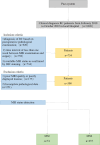A combinatorial MRI sequence-based radiomics model for preoperative prediction of microsatellite instability status in rectal cancer
- PMID: 38783014
- PMCID: PMC11116457
- DOI: 10.1038/s41598-024-62584-0
A combinatorial MRI sequence-based radiomics model for preoperative prediction of microsatellite instability status in rectal cancer
Abstract
This study aimed to develop an optimal radiomics model for preoperatively predicting microsatellite instability (MSI) in patients with rectal cancer (RC) based on multiparametric magnetic resonance imaging. The retrospective study included 308 RC patients who did not receive preoperative antitumor therapy, among whom 51 had MSI. Radiomics features were extracted and dimensionally reduced from T2-weighted imaging (T2WI), T1-weighted imaging (T1WI), diffusion-weighted imaging (DWI), and T1-weighted contrast enhanced (T1CE) images for each patient, and the features of each sequence were combined. Multifactor logistic regression was used to screen the optimal feature set for each combination. Different machine learning methods were applied to construct predictive MSI status models. Relative standard deviation values were determined to evaluate model performance and select the optimal model. Receiver operating characteristic (ROC) curve, calibration curve, and decision curve analyses were performed to evaluate model performance. The model constructed using the k-nearest neighbor (KNN) method combined with T2WI and T1CE images performed best. The area under the curve values for prediction of MSI with this model were 0.849 (0.804-0.887), with a sensitivity of 0.784 and specificity of 0.805. The Delong test showed no significant difference in diagnostic efficacy between the KNN-derived model and the traditional logistic regression model constructed using T1WI + DWI + T1CE and T2WI + T1WI + DWI + T1CE data (P > 0.05) and the diagnostic efficiency of the KNN-derived model was slightly better than that of the traditional model. From ROC curve analysis, the KNN-derived model significantly distinguished patients at low- and high-risk of MSI with the optimal threshold of 0.2, supporting the clinical applicability of the model. The model constructed using the KNN method can be applied to noninvasively predict MSI status in RC patients before surgery based on radiomics features from T2WI and T1CE images. Thus, this method may provide a convenient and practical tool for formulating treatment strategies and optimizing individual clinical decision-making for patients with RC.
Keywords: Machine learning; Magnetic resonance imaging; Microsatellite instability; Radiomics; Rectal cancer.
© 2024. The Author(s).
Conflict of interest statement
The authors declare no competing interests.
Figures






Similar articles
-
Preoperative radiomics models using CT and MRI for microsatellite instability in colorectal cancer: a systematic review and meta-analysis.Abdom Radiol (NY). 2025 May 10. doi: 10.1007/s00261-025-04981-1. Online ahead of print. Abdom Radiol (NY). 2025. PMID: 40347255 Review.
-
Development and external validation of a multiparametric MRI-based radiomics model for preoperative prediction of microsatellite instability status in rectal cancer: a retrospective multicenter study.Eur Radiol. 2023 Mar;33(3):1835-1843. doi: 10.1007/s00330-022-09160-0. Epub 2022 Oct 25. Eur Radiol. 2023. PMID: 36282309
-
Preoperative prediction of perineural invasion of rectal cancer based on a magnetic resonance imaging radiomics model: A dual-center study.World J Gastroenterol. 2024 Apr 28;30(16):2233-2248. doi: 10.3748/wjg.v30.i16.2233. World J Gastroenterol. 2024. PMID: 38690027 Free PMC article.
-
Development and validation of a radiomics model based on T2WI images for preoperative prediction of microsatellite instability status in rectal cancer: Study Protocol Clinical Trial (SPIRIT Compliant).Medicine (Baltimore). 2020 Mar;99(10):e19428. doi: 10.1097/MD.0000000000019428. Medicine (Baltimore). 2020. PMID: 32150094 Free PMC article.
-
Diagnostic performance of radiomics models for preoperative prediction of microsatellite instability status in endometrial cancer: a systematic review and meta-analysis.Abdom Radiol (NY). 2025 Apr 8. doi: 10.1007/s00261-025-04933-9. Online ahead of print. Abdom Radiol (NY). 2025. PMID: 40195139 Review.
Cited by
-
Novel deep learning algorithm based MRI radiomics for predicting lymph node metastases in rectal cancer.Sci Rep. 2025 Apr 9;15(1):12089. doi: 10.1038/s41598-025-96618-y. Sci Rep. 2025. PMID: 40204902 Free PMC article.
-
Predictive value of combined DCE-MRI perfusion parameters and clinical features nomogram for microsatellite instability in colorectal cancer.Discov Oncol. 2025 May 23;16(1):892. doi: 10.1007/s12672-025-02705-x. Discov Oncol. 2025. PMID: 40410525 Free PMC article.
-
Preoperative radiomics models using CT and MRI for microsatellite instability in colorectal cancer: a systematic review and meta-analysis.Abdom Radiol (NY). 2025 May 10. doi: 10.1007/s00261-025-04981-1. Online ahead of print. Abdom Radiol (NY). 2025. PMID: 40347255 Review.
-
The Role of Predictive and Prognostic MRI-Based Biomarkers in the Era of Total Neoadjuvant Treatment in Rectal Cancer.Cancers (Basel). 2024 Sep 9;16(17):3111. doi: 10.3390/cancers16173111. Cancers (Basel). 2024. PMID: 39272969 Free PMC article. Review.
-
Research progress in multimodal radiomics of rectal cancer tumors and peritumoral regions in MRI.Abdom Radiol (NY). 2025 May 31. doi: 10.1007/s00261-025-04965-1. Online ahead of print. Abdom Radiol (NY). 2025. PMID: 40448847 Review.
References
-
- Trojan J, Stintzing S, Haase O, Koch C, Ziegler P, Demes M, Jelas I. Complete pathological response after neoadjuvant short-course immunotherapy with ipilimumab and nivolumab in locally advanced MSI-H/dMMR rectal cancer. Oncologist. 2021;26(12):e2110–e2114. doi: 10.1002/onco.13955. - DOI - PMC - PubMed
-
- Luchini C, Bibeau F, Ligtenberg MJL, Singh N, Nottegar A, Bosse T, et al. ESMO recommendations on microsatellite instability testing for immunotherapy in cancer, and its relationship with PD-1/PD-L1 expression and tumour mutational burden: A systematic review-based approach. Ann. Oncol. Off. J. Eur. Soc. Med. Oncol. 2019;30(8):1232–1243. doi: 10.1093/annonc/mdz116. - DOI - PubMed
-
- [Consensus of Chinese experts on clinical detection of molecular markers of colorectal cancer]. Zhonghua wei chang wai ke za zhi = Chinese journal of gastrointestinal surgery. 2021;24(3):191–7. Epub 2021/10/15. 10.3760/cma.j.cn.441530-20201225-00679. PubMed PMID: 34645160. - PubMed
MeSH terms
Grants and funding
LinkOut - more resources
Full Text Sources
Medical

